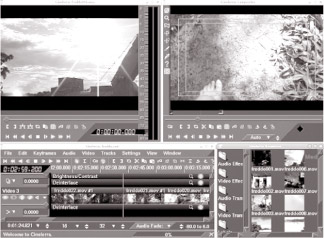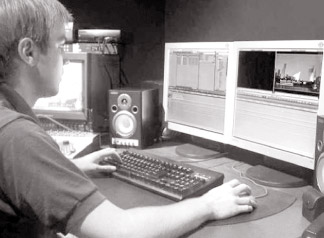|
Faking video footage :
Technology makes everything possible
By Mihindukulasuriya Susantha Fernando
|

Moderen digital editing equipment

|
Britain, has renewed calls for Sri Lanka to investigate allegations
of war crimes after a video footage on Channel 4 of the UK showed
summary execution of naked and bound prisoners. The film reportedly
shows “trophy videos” taken on mobile phones allegedly by Sri Lankan
soldiers taking part in the military operation in 2009 to crush the
Tiger insurgency and end a 30-year conflict.
The video footage shown by Channel 4 has been cleverly faked by a
pro-LTTE supporter in the UK, who had access to a cell phone with
camera, computer and video editing software. The digital video
“revolution” of the 1990s has given wide access to sophisticated editing
and control technology, allowing many amateur artistes to work with
video and to create interactive installations based on video.
Some examples of recent trends in video art include entirely
digitally rendered environments created with no camera. Characters in a
video scene can now be superimposed or removed altogether by new digital
technology.
New video editing software lets you rearrange and even mix or combine
different video clips. With timeline editing you can drag and drop video
clips or files right where you want them. When you have all the clips
you want together, you can add titles, menus and text. Many applications
come with numerous menu and title templates and also let you add text
effects.
For an even more stunning creation you can add music, narration or
sound effects. Beginners can make use of a variety of free video editing
software to edit their videos. Professional video editing software is a
pricey purchase.
As video editing software becomes more advanced and prevalent, there
have been concerns about the true reliability of video evidence. The
latest video editing software, as available in the market today, can
make a tampered video footage appear ‘perfectly real’.
Inadmissible in a court of law
Whether the disputed video footage is real or faked, it would be
inadmissible in a court of law or war crimes tribunal, without the
testimony of a qualified video technologist or a police officer present
at the scene of the purported crime.
Even with such corroborative evidence, how does a court of law know
that the tape is real? How do they know that it has not been edited or
tampered with? How do they know that the people in the tape are the
alleged Sri Lankan soldiers, or LTTE terrorists dressed as ‘Sri Lankan
soldiers’? The LTTE made several incursions into Sinhala villages,
disguised as Sri Lankan soldiers and sometimes as civilians.
As seen by the spurious allegations of war crimes based on the video
footage shown on Channel 4, faked video footage can brainwash
individuals to believe that what is shown therein is ‘absolutely true’.
A study conducted in 2009 by Warwick University found that exposure to
fabricated footage can “dramatically alter” individuals’ version of
events, even convincing them to testify as an eyewitness to an event
that never happened.
The study also found that almost 50 percent of people who were shown
false footage of an event they witnessed first hand were prepared to
believe the video version rather than what they actually saw.
Lead researcher Dr Kimberley Wade, Associate Professor of Psychology
at Warwick University, said the results were “scary” and showed just how
easily an eyewitnesses’ account of an event would be distorted.
Dr. Wade and her team filmed 60 subjects as they took part in a
computerised gambling task. Each subject was unknowingly seated next to
a member of the research team as they both separately answered a series
of multiple-choice general knowledge questions. All the subjects were
given a pile of fake money to gamble with and they shared a pile of
money that represented the bank. Their task was to earn as much money as
possible by typing in an amount of money to gamble on the chances of
them answering each question correctly. They were told the person who
made the highest profit would win a prize.
When the participants answered each question, they saw either a green
tick on their computer monitor to show their answer was correct, or a
red cross to show it was incorrect. If the answer was wrong, they would
be told to return the money to the bank.
After the session, the video footage was doctored to make it look as
if the member of the research team who sat next to the subject was
cheating by not putting money back in the bank.
One third of the subjects were told that the person who sat next to
them was suspected of cheating. Another third were told that that person
had been caught on camera cheating, and the remaining group were
actually shown the fake video footage. All subjects were then asked to
sign a statement only if they had seen the cheating taking place.
Nearly 40 percent of the participants who had seen the doctored video
complied. Another 10 percent of the group signed when asked a second
time by the researchers.
Only 10 percent of those who were told the incident had been caught
on film but were not shown the video agreed to sign, and about five
percent of the control group who were just told about the cheating
signed the statement.
Study implications
It is easy to doctor video footage with new technology, Dr Wade said:
“The implications of this study mean we have to be more aware about new
technology and about how easy it is to doctor video footage.
“You can’t believe everything you read or see and this is the first
study of memory distortion that involved people actually accusing
another person of doing something wrong, by evidence of doctored video
footage.
“The results are quite powerful because the subjects who thought they
saw the cheating also signed a statement saying they would be prepared
to testify.
“So if this was a crime and they were witnesses, the person accused
could actually end up in prison.”
Dr Wade also said that the subjects of the experiment had no idea
they were involved in a memory distortion study and that they were
really surprised when they found out that what they thought they had
seen hadn’t actually taken place. She said: “The subjects were really
intrigued when we told them the truth and most took it really well when
they found out they had accused someone of doing something they hadn’t
done”. “Over the previous decade we have seen rapid advances in
digital-manipulation technology, among others, things such as
airbrushing.
“As a result, almost anyone can create convincing, yet fake, images
or video footage. Again our research shows that if fake footage is
extremely compelling, it can induce people to testify about something
they never witnessed.”
(The writer is a veteran video photographer, graphic artist, author
and journalist.)
|

